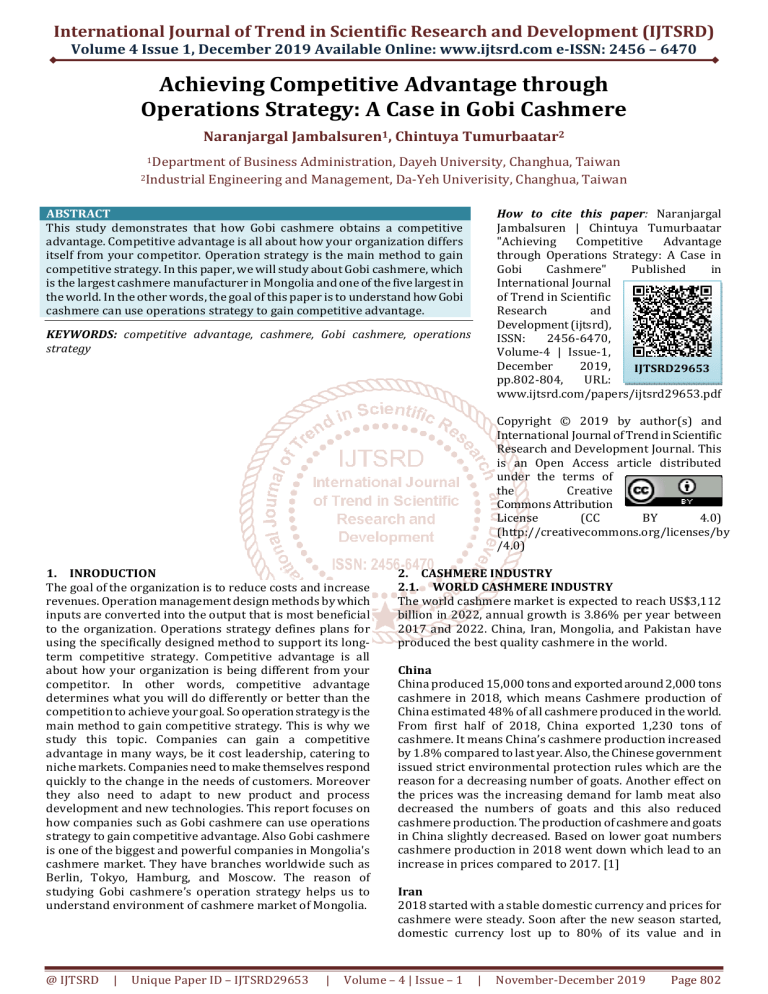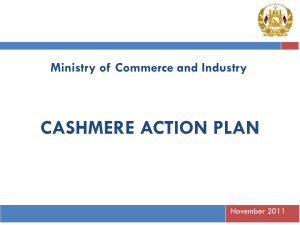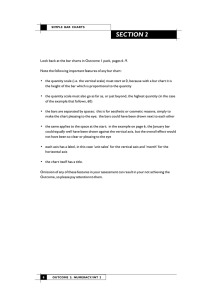
International Journal of Trend in Scientific Research and Development (IJTSRD)
Volume 4 Issue 1, December 2019 Available Online: www.ijtsrd.com e-ISSN: 2456 – 6470
Achieving Competitive Advantage through
Operations Strategy: A Case in Gobi Cashmere
Naranjargal Jambalsuren1, Chintuya Tumurbaatar2
1Department
2Industrial
of Business Administration, Dayeh University, Changhua, Taiwan
Engineering and Management, Da-Yeh Univerisity, Changhua, Taiwan
How to cite this paper: Naranjargal
Jambalsuren | Chintuya Tumurbaatar
"Achieving
Competitive
Advantage
through Operations Strategy: A Case in
Gobi
Cashmere"
Published
in
International Journal
of Trend in Scientific
Research
and
Development (ijtsrd),
ISSN:
2456-6470,
Volume-4 | Issue-1,
December
2019,
IJTSRD29653
pp.802-804,
URL:
www.ijtsrd.com/papers/ijtsrd29653.pdf
ABSTRACT
This study demonstrates that how Gobi cashmere obtains a competitive
advantage. Competitive advantage is all about how your organization differs
itself from your competitor. Operation strategy is the main method to gain
competitive strategy. In this paper, we will study about Gobi cashmere, which
is the largest cashmere manufacturer in Mongolia and one of the five largest in
the world. In the other words, the goal of this paper is to understand how Gobi
cashmere can use operations strategy to gain competitive advantage.
KEYWORDS: competitive advantage, cashmere, Gobi cashmere, operations
strategy
Copyright © 2019 by author(s) and
International Journal of Trend in Scientific
Research and Development Journal. This
is an Open Access article distributed
under the terms of
the
Creative
Commons Attribution
License
(CC
BY
4.0)
(http://creativecommons.org/licenses/by
/4.0)
1. INRODUCTION
The goal of the organization is to reduce costs and increase
revenues. Operation management design methods by which
inputs are converted into the output that is most beneficial
to the organization. Operations strategy defines plans for
using the specifically designed method to support its longterm competitive strategy. Competitive advantage is all
about how your organization is being different from your
competitor. In other words, competitive advantage
determines what you will do differently or better than the
competition to achieve your goal. So operation strategy is the
main method to gain competitive strategy. This is why we
study this topic. Companies can gain a competitive
advantage in many ways, be it cost leadership, catering to
niche markets. Companies need to make themselves respond
quickly to the change in the needs of customers. Moreover
they also need to adapt to new product and process
development and new technologies. This report focuses on
how companies such as Gobi cashmere can use operations
strategy to gain competitive advantage. Also Gobi cashmere
is one of the biggest and powerful companies in Mongolia's
cashmere market. They have branches worldwide such as
Berlin, Tokyo, Hamburg, and Moscow. The reason of
studying Gobi cashmere’s operation strategy helps us to
understand environment of cashmere market of Mongolia.
@ IJTSRD
|
Unique Paper ID – IJTSRD29653
|
2. CASHMERE INDUSTRY
2.1. WORLD CASHMERE INDUSTRY
The world cashmere market is expected to reach US$3,112
billion in 2022, annual growth is 3.86% per year between
2017 and 2022. China, Iran, Mongolia, and Pakistan have
produced the best quality cashmere in the world.
China
China produced 15,000 tons and exported around 2,000 tons
cashmere in 2018, which means Cashmere production of
China estimated 48% of all cashmere produced in the world.
From first half of 2018, China exported 1,230 tons of
cashmere. It means China’s cashmere production increased
by 1.8% compared to last year. Also, the Chinese government
issued strict environmental protection rules which are the
reason for a decreasing number of goats. Another effect on
the prices was the increasing demand for lamb meat also
decreased the numbers of goats and this also reduced
cashmere production. The production of cashmere and goats
in China slightly decreased. Based on lower goat numbers
cashmere production in 2018 went down which lead to an
increase in prices compared to 2017. [1]
Iran
2018 started with a stable domestic currency and prices for
cashmere were steady. Soon after the new season started,
domestic currency lost up to 80% of its value and in
Volume – 4 | Issue – 1
|
November-December 2019
Page 802
International Journal of Trend in Scientific Research and Development (IJTSRD) @ www.ijtsrd.com eISSN: 2456-6470
accordance, prices rose very sharply. Once the currency
gained some of its value back in October of 2018, prices
dropped as well. During this period it is estimated that more
than 60% of Iranian cashmere was bought by Chinese
traders directly or through their Iranian and Afghan agents.
In recent months prices for meat have risen sharply and the
government is importing a lot of meat as well. If the meat
supply is not sufficient for the country’s demand, herders
will be tempted to sell goats for meat because the surge for
meat price is bigger than for cashmere prices. In this case,
cashmere production will decrease in quantity while prices
will naturally increase. [1]
2.1.1. MONGOLIAN CASHMERE INDUSTRY
The agriculture sector is the main factor of the Mongolian
economy. In 2017, agriculture accounted for 18% of
Mongolia's gross domestic product and employed 30% of the
country's workforce. Agricultural products, accounting for
8% of total exports in terms of value in 2017, are the secondlargest export item after mineral products. One-third of
Mongolia's population lives in rural areas and their
livelihoods are highly dependent on animal husbandry, with
78% of rural households owning livestock. Raw materials
and semi-processed goods accounted for over 76% of
Mongolia’s agricultural exports in 2017.
Mongolia's climate is suitable for cashmere goats, which
means the country has a natural competitive advantage in
cashmere production. Mongolia is the second-largest
producer of cashmere in the world with about 40% of world
production, compared to China’s 48% and lesser percentages
for Iran, Afghanistan, South Africa, the United States, and
Australia. Cashmere is one of Mongolia's major agricultural
commodities and the main source of livelihood for
Mongolian herders. Despite this high level of raw cashmere
production, only 10% of raw cashmere is fully processed
domestically. [2] Since the 1970s the Mongolian tableland
has been producing the great majority of the world's
cashmere. Mongolia and Inner Mongolia of China are the
main competitors in the global cashmere market.
The objectives of the Government of Mongolia for the
cashmere industry are to develop the cashmere industry so
that it makes a significant contribution both to economic
growth and to poverty alleviation. To achieve these twin
objectives it assists the development of the herders whose
goats supply the raw cashmere and the downstream
processing industry that adds value to the raw cashmere
before export. For herders the government of Mongolia
offers free education for their children, virtually no taxes
(only a small per head tax, which is often partly evaded), free
provision of water wells, free veterinarian services, and
fodder at subsidized prices. [3]
Cashmere production companies face to two difficulties:
1. The high cost of the working capital
2. The high demand of raw cashmere in Mongolia
The Government of Mongolia has prioritized the
development of the cashmere industry. The government’s
National Production Program 2016-2020 aims to increase
the share of value-added products in the national GDP and
boost the production of goods for export. The program also
addresses the supply chain development of raw materials,
including cashmere. In February 2018, the government
@ IJTSRD
|
Unique Paper ID – IJTSRD29653
|
renewed its commitment to support the cashmere industry
by launching a 4-year Cashmere Program that will support
domestic production of cashmere end products and
technological innovation in the industry. This program will
continue financial support to cashmere producers as well,
partly through concessional loans for raw cashmere
procurement. The government’s goal in supporting the
cashmere industry is to increase export income and create
new jobs.
2.2. THEORY OF COMPETITIVE ADVANTAGES
Competitive advantage is the leverage that a business has
over its competitors. This can be gained by offering clients
better and greater value. Target markets recognize these
unique products or services. This is the reason behind brand
loyalty, or why customers prefer one particular product or
service over another. [4] According to M. Porter, there are
two basic types of competitive advantage, which are cost
advantage and differentiation advantage.
A. COMPETING THROUGH COSTPorter argued that a company could achieve superior
performance by producing similar quality products or
services but at lower costs. In this case, the company sells
products at the same price as competitors but reaps higher
profit margins because of lower production costs. The
company that tries to achieve cost advantages pursuing a
cost leadership strategy. Higher profit margins lead to
further price reductions, more investments in process
innovation and ultimately greater value for customers. [5]
B. COMPETING THROUGH DIFFERENTIATESDifferentiation advantage is achieved by offering unique
products and services and charging a premium price for that.
Differentiation strategy is used in this situation and the
company positions itself more on branding, advertising,
design, quality and new product development rather than
efficiency, outsourcing or process innovation. Customers are
willing to pay a higher price only for unique features and the
best quality. A company with a differentiation strategy can
charge a premium price. That means it usually has a higher
profit margin. [5]
If the company works successfully in the market, its product
or service supposed to offer value at a reasonable price and
good quality. If the company can deliver products or
services, which is different, unique, and based on their
customers' needs and desires, they will powerful competitor
in the market.
3. FINDINGS
3.1. ACHIEVING COMPETITIVE ADVANTAGE THROUGH
OPERATION STRATEGY: GOBI CASHMERE
Gobi is the largest cashmere production company in
Mongolia. The Company has four factories: primary
processing, spinning, knitting, and weaving. The company
can produce 1100 tons of raw cashmere, 30 tons of woven
cashmere and 210 tons of combed cashmere per annum. [6]
the Gobi manages its entire value chain, from sourcing raw
cashmere directly from herders to processing and
manufacturing cashmere products at its primary and
secondary processing facilities in Ulaanbaatar. Gobi designs,
manufactures, and sells its own branded products
domestically through its domestic branches and
internationally through its international branches, franchise
Volume – 4 | Issue – 1
|
November-December 2019
Page 803
International Journal of Trend in Scientific Research and Development (IJTSRD) @ www.ijtsrd.com eISSN: 2456-6470
stores, and online shop. Most of Gobi Corporation branch
stores located in Zaisan, where businessmen, politicians, and
the main street of Ulaanbaatar (the capital city of Mongolia).
Gobi is segmenting high-value customers.
The increase in primary processing and storage capacity will
allow the Gobi to procure more raw cashmere from herders.
During the raw cashmere production season (March–June of
each year), Gobi deploys its procurement team across
Mongolia to inspect and purchase raw cashmere directly
from herders. Gobi also purchases raw cashmere at its
factory from intermediaries. About 60% of Gobi's raw
cashmere procurement is from its procurement team and
40% is received at its factory from intermediaries. Gobi
plans to increase the share of raw cashmere procurement
from its procurement team and direct procurement from
herders (to at least 180 tons from 650 herders by 2022) to
gain stronger control over its raw cashmere quality. Gobi
also provides basic extension services to certain herders in
the form of provision of goat blankets and cashmerecollecting sacks. Additionally, as the Gobi intends to locate its
new primary processing facility outside of Ulaanbaatar, Gobi
will directly contribute to the local economy by employing
staff from the local community and increasing procurement
of raw cashmere from the herders.
The majority (68%) of Gobi customers are based outside of
Mongolia. While 60% of Gobi's sales are domestic, almost
half of domestic sales are to foreign tourists, and 40% of
Gobi's sales are exported. In addition to its 10 retail stores in
Mongolia, Gobi has 50 franchise stores and 5 branch stores
operating in 34 cities across 13 countries. Gobi also produces
finished goods for 211 companies from 32 countries in
accordance with the companies' design specifications. Gobi's
export sales from its international branch stores and online
channels are a relatively new development: its first
international branch store opened in Berlin in November
2016 and its online store started in February 2017. As Gobi's
midterm strategy is to expand its international sales, it will
give priority to marketing and selling its own-branded
products abroad through its international branches,
franchise stores, and online channel. Coats, scarves, throws,
and blankets constitute the Company’s most popular
offerings. To expand its product offerings and embrace a
more environmentally friendly image, Gobi introduced 20
brands and collections, including Organic Mongolian
@ IJTSRD
|
Unique Paper ID – IJTSRD29653
|
Cashmere, Yama Cashmere, Gobi-Mazaalai Collection, Basic
Collection, Baby Camel Wool and Summer Light Cashmere.
The management seeks to increase sales exports share in
coming years through active marketing and a higher-end
product mix. [6]
4. CONCLUSION
The goal of this report is to understand how Gobi cashmere
can use operations strategy to gain competitive advantage.
In the cashmere industry, raw material’s supply is very
important. Due to the seasonality of cashmere wool
harvesting, the company’s year-long supply must be
purchased all at once. Gobi deploys its procurement team
across Mongolia to inspect and purchase raw cashmere
directly from herders. Gobi also purchases raw cashmere at
its factory from intermediaries. The company believes that
this is the only way to afford a sustainable supply of highquality Mongolian cashmere. Sustainable supply is the main
factor that reduces the cost of cashmere products. Gobi has
invested in the new product such as eco-friendly products
like Organic Cashmere and Gobi-Mazaalai Collection, Basic
Collection, Baby Camel Wool and Summer Light Cashmere.
To stay competitive in the global market, eco-friendly
collections will differ the Gobi from its competitors.
5. REFERENCES
[1] Annual cashmere market report 2018, Marco Spina
https://www.gschneider.com/2019/03/01/annualcashmere-market-report/
[2] Value chain analysis of the Mongolian cashmere
industry, 2005, USAID
[3] Cashmere industry in Mongolia updated 2016, Jeffrey
Hays
[4] Italian Sparkling Wines Industry, 2016, Giulia Vignati
[5] Vision and mission statement and competitive
advantage
http://mbasdimt.blogspot.com/2017/03/vision-andmission-statement-competeive.html
[6] Gobi
cashmere
equity
report,
2016
https://frontcap.com/wpcontent/uploads/2017/03/G
obiCashmereEquityReport
[7] Value-Added Cashmere Production and Export Project
2018, Asian Development Bank
Volume – 4 | Issue – 1
|
November-December 2019
Page 804




